News from Our Scientists - Archive
Research by scientists at the Natural History Museum of Utah formerly featured in the News from Our Scientists exhibition.
Mapping the Lives of Trees — 2023-2024
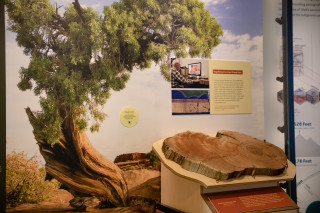
NHMU scientists are utilizing Google Earth in a whole new way. Instead of exploring the globe, they use it to map the lives of ancient trees.
The annual growth rings of the trees used in this research show rainfall, drought, and wildfire conditions - all of which impacted the trees growth. Scientists use magnified, high-resolution images of tree rings finer than a human hair, and measure them with mapping tools in Google Earth.
The exhibit features a slab from a 1500-year-old bristlecone pine. Scientists use the rings on the slab to identify what conditions aided the tree's growth, and when the tree died. This slab was harvested by NHMU scientists in 2016.
Seeing Collections in New Ways — 2022
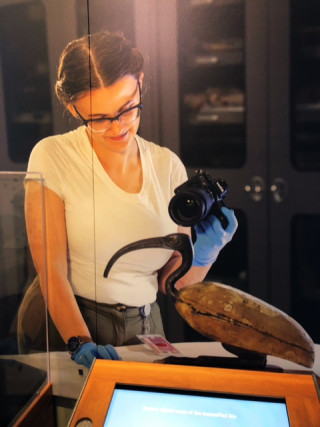
There's more to many museum artifacts than meets the eye. Digital technologies help scientists unlock hidden stories. In our current News from Our Scientists exhibit we're telling the story of how CT scans revealed an ibis preserved in an Egyptian mummy.
Digital and CT Scanning, photography, and 3D printing give scientists new ways to see beyond the surface of artifacts and manipulate and test them in computer models. Digitized objects can be shared globally and utlized by scientists everywhere.
The exhibit features an Ibis coffin with a mummified Ibis that was a gift to the University of Utah from Egyptian President Anwar El-Sadat in 1977.
Cambrian Fossils — 2021
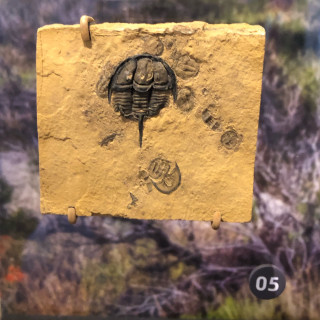
The fossil record captures the story of life on Earth. This exhibit highlights newly acquired Cambrian fossils from the Bureau of Land Management.
The Cambrian Period is considered the dawn of animal life on our planet half a billion years ago.
Undercover Shrews — 2020
The exhibit featured the work of NHMU vertebrate zoologists Shannen Robson and Eric Rickart, who have revealed that habitat ranges for the dwarf shrew (Sorex nanus) and the Inyo shrew (Sorex tenellus) are much larger than once identified.
Shrews are tiny, mysterious mammals, so small that they often fail to set off conventional mammal traps. This led scientists to believe they were rare. However, using new techniques, NHMU scientists are learning more about these stealthy shrews.
Coming Home — 2018
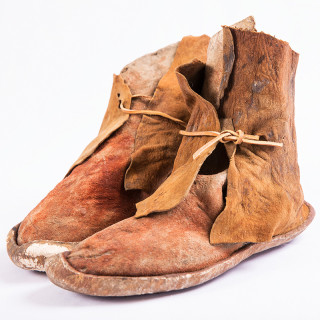
This exhibit featured a small selection of 14 Native American artifacts collected by Major John Wesley Powell and his cartographer, Frank Marion Bishop, that were recently returned to the state of Utah.
Included are a number of Native American baskets that were collected by Bishop, a Native American child's wearing blanket, moccasins, a wooden bow and its sheath, and more. The objects, transferred from Illinois State University in 2018, help tell the fascinating story of Powell, who was a talented geologist and known explorer of the American West.
Fireflies in Utah — 2018
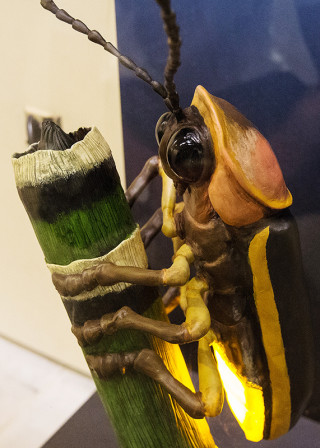
Many people are surprised to discover fireflies inhabit Utah, yet, specimens in NHMU’s collection show they have lived here a long time.
Few scientists, however, have studied our local fireflies. Now, researchers at NHMU and Brigham Young University are joining forces with citizen scientists to find out where Utah fireflies live, how human and environmental factors impact them, and how they are related to other fireflies around the country.
Learn more about their efforts and the bioluminescent beetles they study at the News From Our Scientists exhibit at NHMU.
Read more about NHMU's efforts to document fireflies in Utah.
Utah's Ancient Potato — 2017
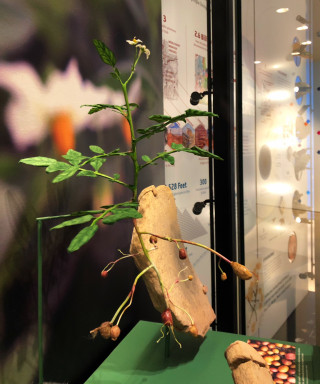
Four Corners Potato (Solanum jamesii) featured the work of NHMU Curator Lisbeth Louderback, Red Butte Garden Conservation Director Bruce Pavlik and a team of collaborators.
By examining plant residues in the crevices of a nearly 11,000 year-old tool found in Escalante, Utah, the researchers were able to identify starch grains from S. jamesii and therefore establish the earliest evidence of wild potato use in North America. These potatoes are native to southern Utah and were used by Native Americans throughout the Four Corners region.
Read more about the research here.
Special thanks to our research colleagues and collaborators
John Bamberg (US Potato Genebank)
Alfonso del Rio (University of Wisconsin)
David Kinder (Ohio Northern University)
Joette-Marie Rex and family (Slot Canyons Inn, Escalante)
Delane Griffin (Pioneer descendent, Escalante)
Cynthia Wilson (Utah Diné Bikéyah)
Gavin Noyes (Utah Diné Bikéyah)
Max Taylor (Hopi Tribe Water Resources Program)
Heidi Redd and family (Dugout Ranch, San Juan County)
Drew Parkin (Economic Planner, Escalante)
David Delthony (Sculptured Furniture Artist, Escalante)
Gwendolyn Zeta (Escalante resident)
Dennis Bramble (Escalante River Watershed Partnership)
Hunting for Treasures — 2017

Hunting for Treasures featured unique mineral specimens donated to the Natural History Museum of Utah by Dennis King, a skilled collector from Utah who has explored the country hunting for unusual and spectacular minerals. Those on display included fluorite, goethite pseudomorph after pyrite, a stunning geode lined with quartz, and azurite.
The exhibit encouraged guests to explore the ground before them, develop their observation skills, pick up a guidebook, and learn the best locations in Utah to discover mineral treasures of their own. One can find more than 150 different minerals and fossils within a 100-mile radius of Salt Lake City alone!
Click here to see more unique gems and minerals on display at NHMU.